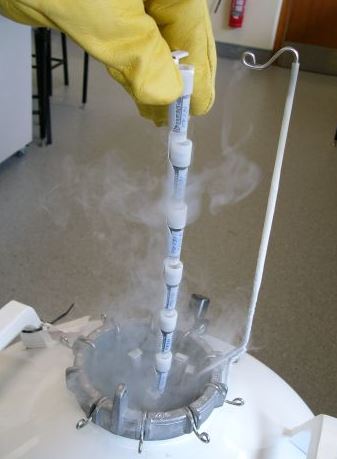Why Tissue Culture is Key to the Future of the Cannabis Industry
Part II: Future Applications for Cannabis Tissue Culture
Guest post by Michael Stevens, Founding Partner at Meristematic Labs
Modern commercial agriculture relies heavily on tissue culture related technologies for commercial production and development. Banana, sugarcane, rice, orchids, corn, soy, ferns and cotton have successfully used tissue culture technologies to make significant crop improvements in recent years. It seems clear that there are considerable opportunities to apply sophisticated tissue culture technologies to the cannabis market.
Micropropagation:
Of all the applications of tissue culture technology, tissue culture based micropropagation presents the greatest opportunity to the commercial cannabis industry. The ability to produce a “True to Type”, pest and disease free starter plants will undoubtedly be crucial to optimization of large-scale cultivation projects. Additionally, all growers, regardless of size, will benefit from the improved plant vigor and crop uniformity commonly seen in starter plants derived from tissue culture. We only need to look to the numerous large-scale micropropagation laboratories around the globe, providing millions of plants for the commercial ornamental and agricultural markets, to see the benefits of tissue culture micropropagation.
During the early years of crop-specific tissue culture micropropagation, the necessary expenses of skilled staff, lab facilities, and electricity, drove the per unit cost significantly higher than more traditional methods of production. This made micropropagation viable only for a limited number of high value crops and endangered plants species. With the introduction of LED lighting and improved quality control software systems, production costs have now become competitive.
As recreational cannabis is adopted in the United States, demand for cannabis starter plants will undoubtedly grow in a dramatic fashion. Between the needs of an increasing number of large-scale cultivars and the growth of straight to consumer starter plant retail sales, fulfillment solutions will be needed. Tissue culture based micropropagation is one of the few methods capable of producing starter plants in quantities to meet this demand.
Crop Improvement:
Tissue culture technologies are often key in large-scale crop improvement programs. Advanced techniques for the culture of protoplasts, anthers, microspores, ovules and embryos have been used to create new genetic variation in plant phenotypes responsible for some of the most significant commercial crop improvements¹. The implementation of these technologies will power the development of “Elite” cannabis genetics that have specific traits as well as the ability to thrive in a variety of environments. Additional benefits can be realized through the use of single cell and meristem-based tissue culture technology for the eradication of pathogens. The introduction of pathogen-free starter plants, both in the case of food and ornamental crops, has been shown to produce considerable yield improvements for large-scale cultivars. Additionally, the diagnosis and treatment of plant disease can be done while the plants are still in tissue culture thereby reducing the use of antifungal, and antibacterial chemicals when compared to treatment in a greenhouse or field.
Phenotype Storage:
As the cannabis industry shifts its focus on phenotype-based Intellectual Property rights and branding opportunities, there will be a real need for long and short-term phenotype storage. For entities claiming legal possession of a particular cannabis phenotype, it will be key to maintain the original living plant sample. With the increase of sophisticated cannabis marketing campaigns and the development of commercial trends, access to Elite phenotypes and cannabis genetic information will be necessary for both large-scale  cultivation and further trait development. Storage solutions will also be needed for studies that involve the medical benefits of Cannabis since genetically identical phenotypes must be available for study replication and future research.
cultivation and further trait development. Storage solutions will also be needed for studies that involve the medical benefits of Cannabis since genetically identical phenotypes must be available for study replication and future research.
Current methods for the preservation of original cannabis phenotypes involves maintaining multiple mother plants of a particular strain at different grow locations. This approach is simply not sustainable for large-scale commercial applications. Not only does it carry a high risk of loss of genetic information, the maintenance of multiple mother plant locations is far more expensive as compared to the use of tissue culture.
Many plants have shown an ability to be stored in tissue culture at low temperature for long periods of time without cell damage. Once returned to normal temperature, cultures can be used for plant production without issue. It is for this reason that tissue culture is currently being relied upon for the cryogenic preservation of the world’s endangered plant species as well as the short-term storage of commercial plant phenotype stock².
Cannabis Bioengineering:
Even with the cannabis industry still in its infancy, there are already companies planning on developing transgenic cannabis products. Tissue culture techniques, in combination with highly specialized molecular techniques, have been successfully used to incorporate specific desired traits through gene transfer³. Cannabis, like all the high value food and medicinal plants, will continue to be of special interest to the biotech industry. While it will likely be many years, if not decades, before we see transgenic products entering the cannabis consumables market, the potential realization of transgenic cannabis products for the non-consumable & hemp markets is on the horizon.
As the need for tissue culture becomes clear to cannabis cultivators, and more cannabis tissue culture labs open for business, a new high-level sector of the cannabis industry is emerging. New business models based around tissue culture and customized technologies specifically for cannabis cultivation will foster this next stage of development.
¹Crop improvement through tissue culture. Brown, D.C.W. & Thorpe, T.A. World Journal of Microbiology & Biotechnology (1995) 11: 409. doi:10.1007/BF00364616
²Suitability of Cryopreservation for the Long‐term Storage of Rare and Endangered Plant Species: a Case History for Cosmos Atrosanguineus. Authored by: Tim Wilkinson, Andrew Wetten, Chrissie Prychid and Michael F. Fay.
³Crop improvement through tissue culture. Brown, D.C.W. & Thorpe, T.A. World Journal of Microbiology & Biotechnology (1995) 11: 409. doi:10.1007/BF00364616
About the author:
 Michael J. Stevens has been an innovator in the cannabis community for the last 20+ years. As a cannabis activist living in Southern California in the mid 90s, he participated in a number of local direct actions to protest cannabis prohibition. Eventually relocating to San Francisco in 1997, he quickly integrated into the Bay Area cannabis community. During his time in Northern California he developed a number of popular cannabis phenotypes.
Michael J. Stevens has been an innovator in the cannabis community for the last 20+ years. As a cannabis activist living in Southern California in the mid 90s, he participated in a number of local direct actions to protest cannabis prohibition. Eventually relocating to San Francisco in 1997, he quickly integrated into the Bay Area cannabis community. During his time in Northern California he developed a number of popular cannabis phenotypes.
In 2009, Mr. Stevens started working on the development of an industrial process for the Micro-propagation of Cannabis plants. January 2015, Meristematic Labs was launched.
Are you a cannabis industry thought leader and want to be heard? Let us know your story.

